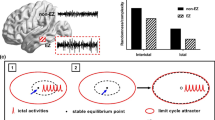Abstract.
A simple mathematical model describing the generation and propagation of epileptiform activity in a cerebral cortical network is presented. The model consists of a system of nonlinear delay differential equations. Physiological properties are taken into account as nonlinear transmission of signals at the synapse, temporal and spatial summation of incoming signals at the soma, active membrane characteristics, and dendritic and axonal propagation times. The influence of the connectivity and the temporal parameters on the oscillatory properties of the model is studied. The computer simulations are in agreement with experimental observations in cortical networks: whereas a weak excitatory or strong inhibitory synaptic connection strength produces a stationary status with short-lasting responses to external stimuli, increases in excitation or decreases in inhibition induce spontaneous and stimulus-evoked rhythmic discharges. Synaptic burst-like activity is observed only for an intermediate range of excitatory and inhibitory connection strengths and external inputs. The form and duration of the bursts can also be controlled by the temporal parameters. The results demonstrate that relatively simple mathematical equations are sufficient to model some of the network properties underlying the generation and propagation of epileptiform activity.
Similar content being viewed by others
Author information
Authors and Affiliations
Additional information
Received: 2 October 2000 / Accepted in revised form: 4 March 2001
Rights and permissions
About this article
Cite this article
Giannakopoulos, F., Bihler, U., Hauptmann, C. et al. Epileptiform activity in a neocortical network: a mathematical model. Biol Cybern 85, 257–268 (2001). https://doi.org/10.1007/s004220100257
Issue Date:
DOI: https://doi.org/10.1007/s004220100257




